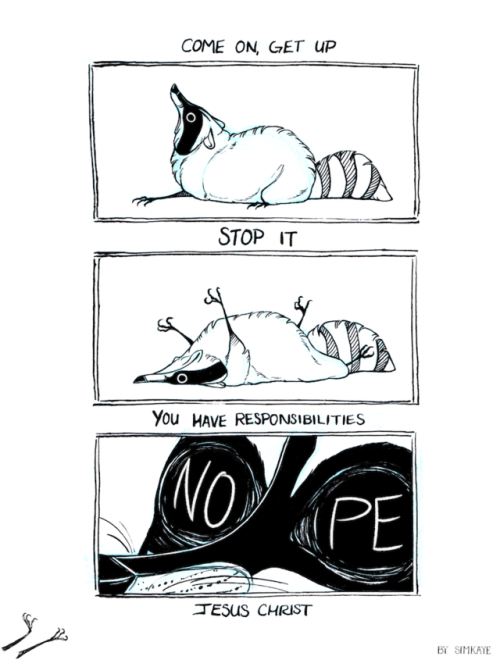34. Responsibilities

34. Responsibilities
More Posts from Possiblyfromorion and Others
“I’ve found that growing up means being honest. About what I want. What I need. What I feel. Who I am.”
—
Epiphany
One understands only in proportion to becoming himself that which he understands.
Søren Kierkegaard, Journals and Papers (via philosophybits)
The Difference between ENTPs and INTPs
Let’s be honest, a lot of people confuse ENTPs and INTPs. Is it possible to figure out why that is? Well, probably only an xNTP can figure it out.
It’s easy to confuse an ENTP for an INTP because they share the same cognitive functions. INTPs are Ti-Ne-Si-Fe, while ENTPs are Ne-Ti-Fe-Si. An individual who’s good at juggling those functions can easily come off as something they’re not. This applies to all introvert versus extrovert dichotomies.
But here’s the thing. When you switch I for E, the top function changes from a judging function to a perceiving function or vice verse. I can’t speak for the other switches, but in INTPs vs ENTPs, this can be pretty obvious - at least to me, considering I am one.
In a nutshell, INTPs take something complicated and make it simple. ENTPs take something simple and make it complicated.
Now, neither of these is good nor bad, it’s just how we function. But let’s explore it.
INTPs have Ti first and Ne second. That means an INTP is predominantly a judger; he or she likes to have things decided. The thing is, this judging function is internal, so that decisiveness is internal. That means an INTP’s concern is primarily with ideas and internal life, where an INTP can narrow down an idea down to its most basic core. This is how an INTP “takes something complicated and makes it simple”. An INTP is far more concerned with absorbing an idea through Ne and stripping it down with Ti, in order to connect it back to other ideas with Ne.
In contrast, ENTPs lead with Ne and have Ti second. When Ne leads, it wants to project outwards and see what’s out there. In this case, Ti serves as a leash, to make sense of and organize all the ideas and data coming in from Ne. In the case of an ENTP, the logic is there to gain an understanding of an idea, and then intuition wants to expand on that and explore the possibilities. In this way, the Ne overrides the Ti - it’s not about cutting down to the core of an idea, so much as understanding an idea enough to see what its possibilities are.
Now, neither of these are better than the other. I know a lot of ENTPs and they’re fantastic people to interact with. But the reality of the situation is that if you understand the difference, they have very different motivations. The INTP wants to understand what is, and the ENTP wants to understand what could be.
So there you have it. Ignore social conventions, and try to pay attention to where a conversation goes. The INTP will try to close down options and come down to a single idea, whereas the ENTP will try to open up options and see what a single idea can mean.
Does that help at all?
“Stress, worry, and anxiety simply come from projecting your thoughts into the future and imagining something bad. This is focusing on what you don’t want! If you find that your mind is projecting into the future in a negative way, focus intensely on NOW. Keep bringing yourself back to the present. Use all of your will, and focus your mind in this very moment, because in this moment of now there is utter peace.”
—
Rhonda Byrne
I, too, sing America. I am the darker brother. They send me to eat in the kitchen When company comes, But I laugh, And eat well, And grow strong. Tomorrow, I’ll be at the table When company comes. Nobody’ll dare Say to me, ‘Eat in the kitchen,’ Then. Besides, They’ll see how beautiful I am And be ashamed— I, too, am America.
Langston Hughes, I, Too

[x]
(via scientificphilosopher)










“I need some more water.” (X)
how do you tell an unhealthy isfp from an unhealthy infp? thanks 🙏
UNHEALTHY ISFPs fight against the influence others may have on them, trying to hold on to their independence and individuality. Steve Rogers/Captain America is a prime example of this in Civil War. They become stubborn and defensive of their way of life, not adjusting to the external world as it really is. Harry Potter and Zuko also exhibit this behavior. They both try their hardest to disregard the input of others in an act to preserve their initial Fi judgments. They both have to accumulate more Se experience in order to have a more objective view of themselves and their judgments. For Zuko it takes being exiled, being with his Uncle who pushes him constantly, and making even more mistakes in book 3 to come to a healthier place where he accepts the influence of others on himself.
UNHEALTHY INFPs fight against opposing ideals they find problematic. They challenge others and their ideas hoping to point out the flaws and prove the person they disagree with to be wrong. They can seem more extraverted when they are unhealthy in this way. In their own way by attacking the ideals of others they are trying to defend their own inner ideals from outside influence. Denying their proper Ne to see other viewpoints and the objective world. Their inferior Te is wielded so they believe they are being rationale in their defensive strategy. Amon from Avatar: Legend of Korra is a great example of this. For a non-villain that does this it is important to look at April Ludgate from Parks and Recreation. This behavior is often why she is mistyped as ISTP/INTP. They see her as more impersonal playing devil’s advocate, but when she is trolling people in her passive-aggressive way she is really on the defense trying to preserve her Fi and point out that everyone else is inauthentic.
The Gist:
ISFPs ignore others to preserve their sense of integrity/authenticity. INFPs fight others, almost like devil’s advocate but trying to prove some moral point. Both are stubborn.
ISTJ Fictional Tropes
Like anything in fiction there are always tropes. This include characters based on their MBTI. Now not all characters that are ISTJ fit into these exact tropes and many fit into multiple as you will note in the examples. The following are major tropes these ISTJ characters have a pattern of falling into and I think they help define their type as a whole in the big picture. Hopefully, this can be almost a quick cheat sheet at times when typing characters.
Traditional Leader

These characters are what we think of as your typical leader. They are the ones you trust because they stick to their center, what they feel is right. They’re usually fiercely loyal. These leaders are service oriented. They don’t see themselves as in control, but as serving a role, one that would exist without them. One they choose out of some sense of responsibility or duty to uphold.
Examples: Commander Lexa (The 100), Captain Ray Holt (Brooklyn Nine-Nine), Queen Elizabeth II (The Crown), Lord Eddard Stark (Game of Thrones), Stannis Baratheon (Game of Thrones), George Washington (Hamilton: An American Musical), Thorin (The Hobbit), Fergus (Pixar’s Brave), Theodon (The Lord of the Rings), Powhatan (Disney’s Pocahontas), Queen Catherine of Aragon (The Tudors), Kercheck (Disney’s Tarzan), King George (Once Upon a Time), Elsa (Disney’s Frozen and Once Upon a Time), and Rick Grimes (The Walking Dead).
Detective/Inspector

Most of these character actually are cops, detectives, inspectors, but that is not exactly what this means. This trope for the ISTJ involves them being excited by their inferior Ne. They love to solve things methodically with Si-Te, but get excited by solving puzzles and investigating using their Ne. These types are interested in the truth and their duty to reveal the truth. They will often be willing to break the law/rules in order to uncover the truth. Their loyalty is to what their role upholds, not to people please. The ISTJ is self sacrificing and is okay being painted negatively if the result leads to the truth and justice.
Examples: Quentin Lance (Arrow), Mako (Avatar: Legend of Korra), Captain Ray Hold (Brooklyn Nine-Nine), Barbara Gordon/Batgirl/Oracle (DC Comics), Joe Swanson (Family Guy), Tina Goldstein (Fantastic Beasts and Where To Find Them), Chloe Decker (Lucifer), Inspector Chester Campbell (Peaky Blinders), James Gordon (Gotham and DC Comics), Bonnie Winterbottom (How To Get Away With Murder), Sara Lance (Arrow and Legend of Tomorrow), Javert (Les Miserables), Shikamaru Naru (Naruto Shippuden), Bartholomew Rusk (Penny Dreadful), Anderson (BBC’s Sherlock), Jim Hopper (Stranger Things), Sam Winchester (Supernatural), Sheriff Stalinski (Teen Wolf), Nobuchika Ginoza (Psycho-Pass), and Rick Grimes (The Walking Dead).
Dutiful Soldier

ISTJ characters that fit this trope are often soldiers, however, it isn’t a requirement to be part of this trope. These ISTJs are dedicated to a cause and remain personally connected and loyal to it. They are highly dependable in performing their duty, whatever that role may be. Their tertiary Fi, often influences them morally to be connected to a cause. They work hard and always follow through on a task. This isn’t about following rules created by a system blindly. These character follow a code and if that means breaking the rules to uphold a personal code, they will do it.
Examples: Allison Argent (Teen Wolf), Takashi Morinozuka (Ouran High School Host Club), Mulan (Once Upon a Time), Norrington (Pirates of the Caribbean), Fujitora (One Piece), Bartholomew Rusk (Penny Dreadful), Yamato (Naruto Shippuden), Mako Mori (Pacific Rim), Athos (BBC’s The Musketeers), Ardeth Bay (The Mummy Film Series), Li Shang (Disney’s Mulan), Mike Wazowski (Monsters, Inc.), Mameha (Memoirs of a Geisha), Natasha Romanoff/Black Widow (Marvel Cinematic Universe), Claire Temple (Netflix’s The Defenders Universe), Sebastian (Disney’s The Little Mermaid), Zazu (Disney’s The Lion King), Cogsworth (Disney’s Beauty and the Beast), Harry/Galahad (Kingsman: The Secret Service), Astrid (How To Train Your Dragon), Dr. Eric Foreman (House, MD), Legolas (The Hobbit and The Lord of the Rings), Maximus (Gladiator), Brienne of Tarth (Game of Thrones), Riza Hawkeye (Fullmetal Alchemist: Brotherhood), Zoe Washburne (Firefly), Danny Pink (Doctor Who), Katana/Tatsu Toro (DC Comics), Starfire (DC Comics), Melinda May (Agents of S.H.I.E.L.D.), Jack Thompson (Agent Carter), Indra (The 100), Maggie Greene (The Walking Dead), and Alex Danvers (Supergirl).
The Specialist

This ISTJ is a master of something. They are so focused and will know every fact about their specialization. Whatever they love is part of their identity, it is what defines them and the use of concrete sensing facts is what helps them relate to their interest. When an ISTJ character is dedicated to a passion, no one knows as much as they do about it.
Examples: Hope Van Dyne (Ant-Man), Gray Fullbuster (Fairytail), Sheldon Cooper (The Big Bang Theory), Dr. Caitlin Snow (The Flash), Bob Belcher (Bob’s Burgers), Ross Gellar (Friends), Tatsu Toro/Katana (DC Comics), Riza Hawkeye (Fullmetal Alchemist: Brotherhood), The Swede (Hell on Wheels), Bill Weasley (Harry Potter Series), Doug Guggenheim (House of Lies), Hailey (Mozart in the Jungle), Ben Wyatt (Parks & Recreation), Homura Akemi (Madoka Magica), Uhura (Star Trek Film Series), Lt. Commander Data (Star Trek: The Next Generation), Edward Cullen (Twilight Saga), Natasha Romanoff/Black Widow), and Unalaq (Avatar: Legend of Korra).
Family-Oriented Center

These characters deeply care for their family (not necessarily genetic) and are often found as the grounding center. They may not seem caring like their ISFJ counterparts, but these ISTJ characters are harsh defenders of their families and are often the character others rely on as a steady constant in their lives. When this steady constant falls, many times the family does as well. They are the foundation of their family unit.
Examples: Alexei Alexandrovich Karenin (Anna Karenina), Quentin Lance (Arrow), Ross Geller (Friends), Bob Belcher (Bob’s Burgers), Ned Stark (Game of Thrones), Fergus (Pixar’s Brave), Dean Forester (Gilmore Girls), Mallory Hanson (Grace and Frankie), Maximus (Gladiator), Sophie (Howl’s Moving Castle), Bagheera (Disney’s The Jungle Book), Theodon (The Lord of the Rings), Chloe Decker (Lucifer), Powhatan (Disney’s Pocahontas), Sun Bak (Sense8), Elinor Dashwood (Sense and Sensibility), Fiona Gallagher (Shameless), Red Forman (The ‘70s Show), Edward Cullen (Twilight Saga), Elena Gilbert (The Vampire Diaries), and Maggie Greene (The Walking Dead).
Zealot

The Zealot ISTJ character is often being unwillingly controlled by their inferior Ne. They find the outer world with it’s constant change in meaning separate from their own deep, personal inner meaning is in conflict. They fear change and try to fight it with everything they have. If they admit that the world has this changing meaning outside of themselves they feel everything they believe in is threatened and are unable to cope with such conflict. They refer to their tertiary Fi for comfort and try to morally back their subjective perspective up with subjective judgement. Thereby fueling their own opinion and clinging to their personal identity, unchanging. Many ISTJ villains fall into this trope, but not all are villains. That is important to keep in mind.
Examples: Grinch (Ron Howard’s How The Grinch Stole Christmas), Alexei Alexandrovich Karenin (Anna Karenina), Claude Frollo (Disney’s The Hunchback of Notre Dame), Sheldon Cooper (Big Bang Theory), Javert (Les Miserables), Ross Geller (Friends), Sam Healy (Orange is the New Black), Angela Martin (The Office), Elsa (Disney’s Frozen), P.L. Travers (Saving Mr. Banks), Dean Forester (Gilmore Girls), Lord Voldemort/Tom Riddle (Harry Potter Series), The Swede (Hell on Wheels), Nessarose (Wicked: The Life and Times of the Wicked Witch of the West Novel), Theo Galavan (Gotham), and Unalaq (Avatar: Legend of Korra).
The Cynic

The ISTJ cynics are often mistyped because they don’t really believe in anything. They are often misread as ISTP to be honest. But the Cynic ISTJ is indeed, very ISTJ. They are some of the most ultimate realists, not seeing the light at the end of the tunnel. They usually have life experiences of pain that has formed their perception of reality. Their dominant Si seeing the facts, not fanciful ideals. Their tertiary Fi not seeing or growing up with that feeling that they or anyone else is a special snowflake. They often are lost, without a cause, not trusting those with big ideals. They see things as they are and nothing more. They are the bluntest ISTJ filled with some of the most ironic humor. They are usually disappointed with their lot in life.
Examples: John Murphy (The 100), Mai (Avatar: The Last Airbender), Chas Chandler (Constantine), Helga Katrina Sinclair (Disney’s Atlantis: The Lost Empire), Phantom Stranger (DC Comics), Gwynne (Galavant), Mad-Eye Moody (Harry Potter Series), Suzana Ayuwaza (Maid-Sama), Shikamaru Naru (Naruto Shippuden), Dinesh (Silicon Valley), and Princess Kwenthrith (Vikings).






#chris evans #in where he is actually steve rogers
“You never know what worse luck your bad luck has saved you from.”
— Cormac McCarthy
-
 her-imperius-condessy reblogged this · 7 months ago
her-imperius-condessy reblogged this · 7 months ago -
 starryrika liked this · 11 months ago
starryrika liked this · 11 months ago -
 leeforlee liked this · 1 year ago
leeforlee liked this · 1 year ago -
 rooksnooks reblogged this · 1 year ago
rooksnooks reblogged this · 1 year ago -
 rooksnooks liked this · 1 year ago
rooksnooks liked this · 1 year ago -
 leximaven reblogged this · 1 year ago
leximaven reblogged this · 1 year ago -
 leximaven liked this · 1 year ago
leximaven liked this · 1 year ago -
 des8pudels8kern reblogged this · 1 year ago
des8pudels8kern reblogged this · 1 year ago -
 karennesmith reblogged this · 1 year ago
karennesmith reblogged this · 1 year ago -
 karennesmith liked this · 1 year ago
karennesmith liked this · 1 year ago -
 twpersephone reblogged this · 1 year ago
twpersephone reblogged this · 1 year ago -
 twpersephone liked this · 1 year ago
twpersephone liked this · 1 year ago -
 sarahsoph reblogged this · 1 year ago
sarahsoph reblogged this · 1 year ago -
 sarahsoph liked this · 1 year ago
sarahsoph liked this · 1 year ago -
 piwealthlinkpit liked this · 1 year ago
piwealthlinkpit liked this · 1 year ago -
 myopinionisimportant reblogged this · 1 year ago
myopinionisimportant reblogged this · 1 year ago -
 happycomputertimetravel liked this · 2 years ago
happycomputertimetravel liked this · 2 years ago -
 halelshiyr reblogged this · 2 years ago
halelshiyr reblogged this · 2 years ago -
 phantasticnights reblogged this · 2 years ago
phantasticnights reblogged this · 2 years ago -
 the-fat-cats liked this · 2 years ago
the-fat-cats liked this · 2 years ago -
 quarriawesome liked this · 2 years ago
quarriawesome liked this · 2 years ago -
 23-tiny-wishes reblogged this · 2 years ago
23-tiny-wishes reblogged this · 2 years ago -
 blootooth liked this · 2 years ago
blootooth liked this · 2 years ago -
 arethafranklin liked this · 2 years ago
arethafranklin liked this · 2 years ago -
 harroldhardyng reblogged this · 2 years ago
harroldhardyng reblogged this · 2 years ago -
 whatmarvellousthings reblogged this · 2 years ago
whatmarvellousthings reblogged this · 2 years ago -
 waywardmiraclesstuff liked this · 2 years ago
waywardmiraclesstuff liked this · 2 years ago -
 leolilac reblogged this · 2 years ago
leolilac reblogged this · 2 years ago -
 kahluasin reblogged this · 2 years ago
kahluasin reblogged this · 2 years ago -
 whatmarvellousthings liked this · 2 years ago
whatmarvellousthings liked this · 2 years ago -
 harroldhardyng reblogged this · 2 years ago
harroldhardyng reblogged this · 2 years ago -
 xmissmichix liked this · 2 years ago
xmissmichix liked this · 2 years ago -
 chlorr-no-face reblogged this · 2 years ago
chlorr-no-face reblogged this · 2 years ago -
 capnkyrie reblogged this · 2 years ago
capnkyrie reblogged this · 2 years ago -
 inlilac liked this · 2 years ago
inlilac liked this · 2 years ago -
 23-tiny-wishes reblogged this · 2 years ago
23-tiny-wishes reblogged this · 2 years ago -
 notaprotagonisttimor liked this · 2 years ago
notaprotagonisttimor liked this · 2 years ago -
 notaprotagonisttimor reblogged this · 2 years ago
notaprotagonisttimor reblogged this · 2 years ago -
 ofwings liked this · 3 years ago
ofwings liked this · 3 years ago -
 bubulcitate reblogged this · 3 years ago
bubulcitate reblogged this · 3 years ago -
 carnivalerian reblogged this · 3 years ago
carnivalerian reblogged this · 3 years ago -
 peachy-89 reblogged this · 3 years ago
peachy-89 reblogged this · 3 years ago -
 allonzy-my-wayward-detective liked this · 3 years ago
allonzy-my-wayward-detective liked this · 3 years ago -
 indistinctive-mortal liked this · 3 years ago
indistinctive-mortal liked this · 3 years ago -
 quinbi reblogged this · 3 years ago
quinbi reblogged this · 3 years ago -
 quinbi liked this · 3 years ago
quinbi liked this · 3 years ago
